Related Research Articles

The United Arab Emirates, or simply the Emirates, is a country in West Asia, in the Middle East. It is located at the eastern end of the Arabian Peninsula and shares borders with Oman and Saudi Arabia, while also having maritime borders in the Persian Gulf with Qatar and Iran. Abu Dhabi is the country's capital, while Dubai, the most populous city, is an international hub.

The Emirate of Sharjah is one of the emirates of the United Arab Emirates, which covers 2,590 square kilometres (1,000 sq mi) and has a population of over 1,400,000 (2015). It comprises the capital city of Sharjah, after which it is named, and other minor towns and exclaves such as Kalba', Al Dhaid, Dibba Al-Hisn and Khor Fakkan.

Dubai is the most populous city in the United Arab Emirates (UAE) and the capital of the Emirate of Dubai, the most populated of the country's seven emirates.

Ras Al Khaimah (RAK) is one of the seven emirates that make up the United Arab Emirates (UAE). The city of Ras Al Khaimah, abbreviated to RAK or RAK City, is the capital of the emirate and home to most of the emirate's residents. It is linked to the Islamic trading port of Julfar. Its name in English means "headland of the tent". The emirate borders Oman's exclave of Musandam, and occupies part of the same peninsula. It covers an area of 2,486 km2 (960 sq mi) and has 64 km (40 mi) of beach coastline. As of 2015, the emirate had a population of about 345,000.

The Emirate of Umm Al Quwain is one of the seven constituent emirates of the United Arab Emirates, located in the north of the country. It is the second smallest and least populous emirate in the UAE and borders the Persian Gulf. Umm Al Quwain lies between Ras Al Khaimah and Sharjah/Ajman on the west coast, with a location along the vital trade route between the Middle East and India. It has a coastline stretching to 24 km.

A bazaar or souk is a marketplace consisting of multiple small stalls or shops, especially in the Middle East, the Balkans, North Africa and South Asia. However, temporary open markets elsewhere, such as in the West, might also designate themselves as bazaars. The ones in the Middle East were traditionally located in vaulted or covered streets that had doors on each end and served as a city's central marketplace. Street markets are the European and North American equivalents.

Dubai is one of the world's leading tourism destinations, and tourism in Dubai is a major source of revenue. The city hosted 14.9 million overnight visitors in 2016. In 2018, Dubai was the fourth most-visited city in the world based on the number of international visitors.

Saudi Arabia is the second biggest tourist destination in the Middle East with over 16 million visiting in 2017. Although most tourism in Saudi Arabia still largely involves religious pilgrimages, there is growth in the leisure tourism sector. As the tourism sector has been largely boosted lately, the sector is expected to be the white oil for Saudi Arabia. This is proved as tourism sector is expected to generate $25 billion in 2019. Potential tourist areas include the Hijaz and Sarawat Mountains, Red Sea diving and a number of ancient ruins.

Sharjah is the third-most populous city in the United Arab Emirates, after Dubai and Abu Dhabi. It is the capital of the Emirate of Sharjah and forms part of the Dubai-Sharjah-Ajman metropolitan area.
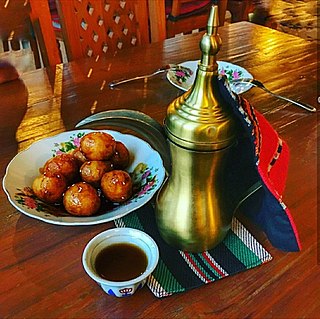
Emirati cuisine is the local traditional Arabic cuisine of the United Arab Emirates. It is part of Eastern Arabian cuisine and shares similarities with cuisines from neighboring countries, such as Omani cuisine and Saudi Arabian cuisine, as well as influences from different Middle Eastern and Asian cuisines.

The culture of the United Arab Emirates'‘ ' is part of the culture of Eastern Arabian. Its historical population was a small tribal community that changed with the arrival of an influx of foreign nationals in the mid-20th century. Emirati culture is a blend of Arabian, Islamic, and Persian cultures, with influences from the cultures of East Africa and Indian Subcontinent. Islam has had a prominent influence on local architecture, music, attire, cuisine, and lifestyle.
Cultural policy in Abu Dhabi, a city within the United Arab Emirates, refers to any initiative undertaken by the Emirate government aimed at achieving goals to contribute to or shape culture. Abu Dhabi's government aims to develop a cultural infrastructure that will allow it to establish itself as a reference point for culture on three levels:
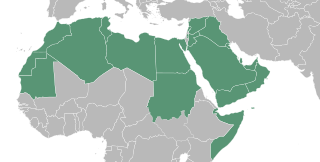
Tourism in the Arab World encompasses a wide array of activities and tourist attractions in an area spanning more than 13 million square kilometers. The Arab World mainly consists of the Arabic-speaking countries and populations in North Africa and Western Asia. The standard definition of the Arab world comprises the 22 countries and territories of the Arab League: 10 countries in Africa, and 12 countries in Asia. Geographically, it stretches from the Atlantic Ocean in the west to the Arabian Sea in the east, and from the Mediterranean Sea in the north to the Horn of Africa and the Indian Ocean in the southeast. It has a combined population of around 422 million people.

The Dubai Textile Souk is a traditional souq (market) of textile products in Dubai's historic Bur Dubai neighbourhood, along the Dubai Creek. It is located in the United Arab Emirates. Opposite to the textile souk on the other side of the Dubai Creek lie the Dubai Spice Souk and Dubai Gold Souk in Deira, accessible via the creek by special abra boats. It is open 10am to 10 pm Saturday to Thursday with some vendors taking a lunch break from 1-4pm and Friday is 4 pm to 10pm only. The souks of Dubai have a rich history of trade within the Persian Gulf region and have developed over time as Dubai urbanised rapidly.

The following outline is provided as an overview of and topical guide to Dubai.
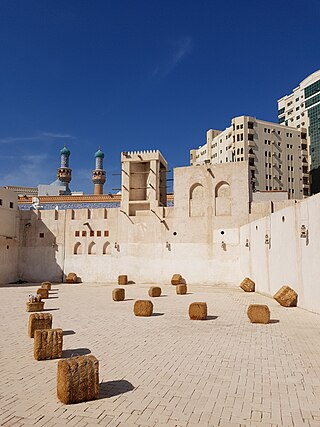
The Heart of Sharjah is a cultural heritage project that aims to preserve and restore the old town of Sharjah in the United Arab Emirates (UAE) and return it to its 1950s state.
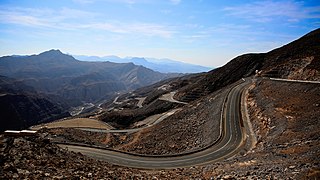
Tourism in the United Arab Emirates is an important component of the Emirati economy, and consists of domestic and international components. In 2018, tourist industry composed over 164.7 billion dirham to country's GDP.
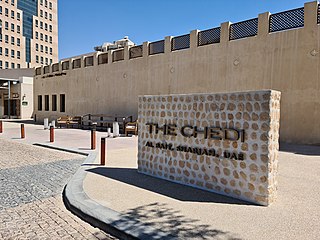
The Chedi Al Bait Hotel is a 53-room five star heritage hotel situated in the Heart of Sharjah cultural heritage area in Sharjah, United Arab Emirates – a restoration of the traditional trading and residential district of Sharjah town.
The Sharjah Archaeology Museum is the first museum in Sharjah, the capital of the Emirate of Sharjah in the United Arab Emirates. It was established on October 5, 1997, by His Highness, the ruler of Sharjah, Sheikh Sultan Bin Muhammad Al-Qasimi, member of the Federal Supreme Council of the United Arab Emirates. The museum is located in the Halwan suburb, close to the infamous Cultural Square in Sharjah. It is considered the first museum in the UAE that specializes in archaeology on a national level. The museum showcases artifacts that were found in Sharjah and that belong to pre-Islamic eras. These discoveries were the results of the archaeologists’ relentless efforts whose missions to Sharjah started from 1973 until contemporary times. They also resulted from the efforts of the local expedition which started in 1993, under the supervision of Professor Sabah Jassim. The department of archaeology falls under the Sharjah Department of Culture. The expedition accomplished a number of important excavations in Sharjah on its own and in partnership with other foreign expeditions.
References
- ↑ "Sharjah — Cultural Capital of the Arab Region in 1998". UNESCO.
- ↑ Kay, Shirley (1992). Sharjah: Heritage and Progress. Motivate Publishing.
- 1 2 Ilyer, Ashok Ganapathy; Deboo, Kairmein; Gandhi, Shweta; Parekh, Dhruv (2019). Architectural & Urban Development of Sharjah: Spatial Analysis of Museums Typology. Sharjah Museums Authority.
- ↑ Hobbs, Joseph John (2017-07-18). "HERITAGE IN THE LIVED ENVIRONMENT OF THE UNITED ARAB EMIRATES AND THE GULF REGION". International Journal of Architectural Research: ArchNet-IJAR. 11 (2): 55. doi: 10.26687/archnet-ijar.v11i2.1240 .
- ↑ Awad, Jihad; Arar, Mohammad; Jung, Chuloh; Boudiaf, Bouzid (2022). "The Comparative Analysis for the New Approach to Three Tourism-Oriented Heritage Districts in the United Arab Emirates". Heritage. 5 (3): 2464–2487. doi: 10.3390/heritage5030128 .
- ↑ UNESCO (2019). "Sharjah. World Book Capital" (PDF). UNESCO Final Report.
- ↑ United Arab Emirates Tours
- ↑ https://www.khaleejtimes.com/uae/from-russia-to-japan-to-uae-an-honour-to-participate-at-sharjah-light-festival-artists-say